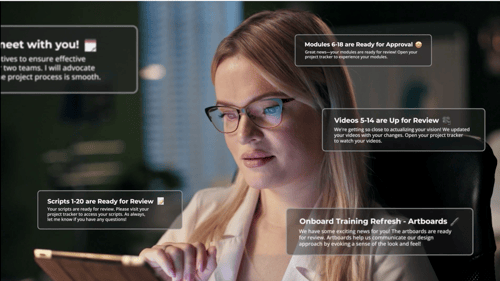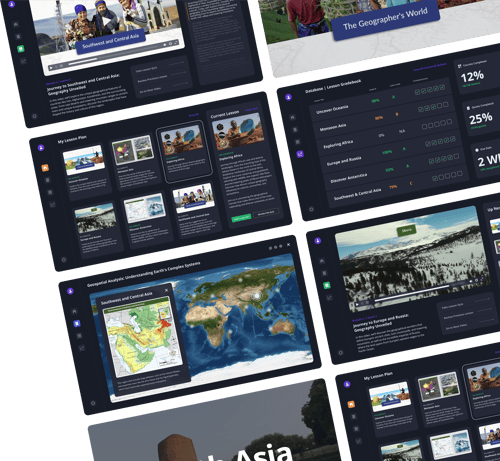There is little doubt about the effectiveness of video as a tool for improving learning. As researchers noted in a report by Kaltura, a provider of a video technology platform, entitled The State of Video in Education, educators overwhelmingly believe video improves the learning experience. To best utilize this, we suggest using video in course design to heighten its effectiveness and enhance learning.
This is likely due, in no small part, to the fact that video has become so pervasive for adults in the U.S. for both information consumption and entertainment. According to eMarketer, the average adult in our country spends more than 5.5 hours daily watching video content. Among the adult population, millennials are the most active video viewers of any age group – more than 92% of all U.S. millennial Internet users watch digital videos.
How to use this information
User familiarity with video as a medium certainly reduces any resistance to form, and allows those designing innovative learning experiences to take advantage of product experience standards that have already been established via other markets. Whether creating instructional videos or social media video content, the barrier for entry on video content is lower than ever.
In addition, thanks to the proliferation of smartphones, video creation has become both easy and flexible for almost everyone. This is reflected in the latest YouTube statistics, which show more than 300 hours of video being uploaded to the service every hour. That’s an abundance of videos produced from smartphones and laptops at home, only to be consumed by potentially thousands of viewers.
So, how can you use video to enhance your learning solutions? Here are 5 suggestions:
1. Video is an effective way to create personal connections in distributed learning environments
Video makes it easy to create a recording of a single instructor or trainer and to deliver an engaging message to many different locations. Just as important, instructional videos allow viewers to make a personal connection with the content by connecting it to a face and a voice. No longer do learning videos have to be a mish mash of talking head videos - they can be engaging and relate to a viewer’s real life. This type of personal connection through video can be expanded significantly through the incorporation of participant-created videos in the form of introductions or feedback. By incorporating feedback and interaction into the course design itself, you can help them reach your learning objectives and know exactly how you did it.
2. Video allows users to work at their own pace and at their own level of understanding
Designed properly, video lessons present clearly defined key concepts or skill components that can be viewed according to each learner’s preferred pace and order. Videos make it easy for learners to revisit key concepts in their own time, as well as skip specific points of training they’ve already mastered. Videos also provide convenient, quick-review modules for learners in need of an information refresh. The dynamic nature of video clips also allows production to switch between long videos and short videos depending on the objectives you’re trying to achieve.
3. Video is an effective medium for modeling skills and processes
Video is an ideal instructional medium for presenting specific skills or processes you want learners to emulate or master. Longer videos and time-lapse graphic integration can help with tedious, involved learning tasks that would otherwise occupy a lot of time. Using properly designed digital learning content, learners can gain a quick and thorough understanding of important skills that would be tedious or ineffective to learn through another medium.
4. Video can be a superior form of performance feedback
Video is often the best way for learners to demonstrate mastery of a concept. Additionally, it’s an ideal medium for providing both instructor and peer-to-peer feedback. Using quality videos for feedback tasks also helps create important, personal connections within the learning process.
5. Video provides natural support for different types of learners
Our learners are never homogeneous. They have different preferences with regard to content types, as well as study approaches and environments. It also varies widely what kind of content works with what kind of delivery method - audio content, visual content, blog content. Different subjects and different learners require versatile mediums and adaptive learning techniques. Each learner also brings different cultural, linguistic, and educational backgrounds to the learning experience. Video as a medium helps address these individual preferences by allowing learners greater personal control of the experience, and through support for closed and language captioning.
In conclusion, developing a vision for your online learning for the next generation needs to keep instructional videos in mind. Instructional designers are capable of designing video content to the learning objectives you have in mind. Incorporating video into educational instruction will enhance student engagement and understanding, as long as video production is deployed thoughtfully and used effectively.

NextThought team
NextThought transforms workplace learning through creative technology and engaging media. We're fortunate to partner with some of the top organizations in the world to make their educational training content remarkable and effective.
Recent Posts

What Can Go Wrong With A Custom Training Project? (And How NextThought Makes It Go Right)
August 5, 2025 1 Min Read

How Much Does a Custom Content Development Project Cost?
July 9, 2025 3 Min Read

The 6 Best Educational Video Production Companies (2025)
February 28, 2025 9 Min Read

